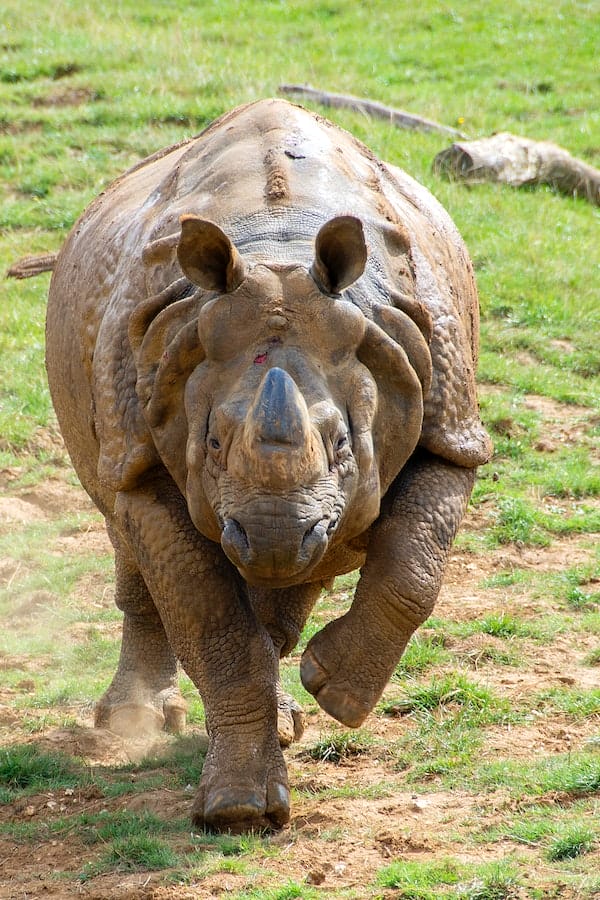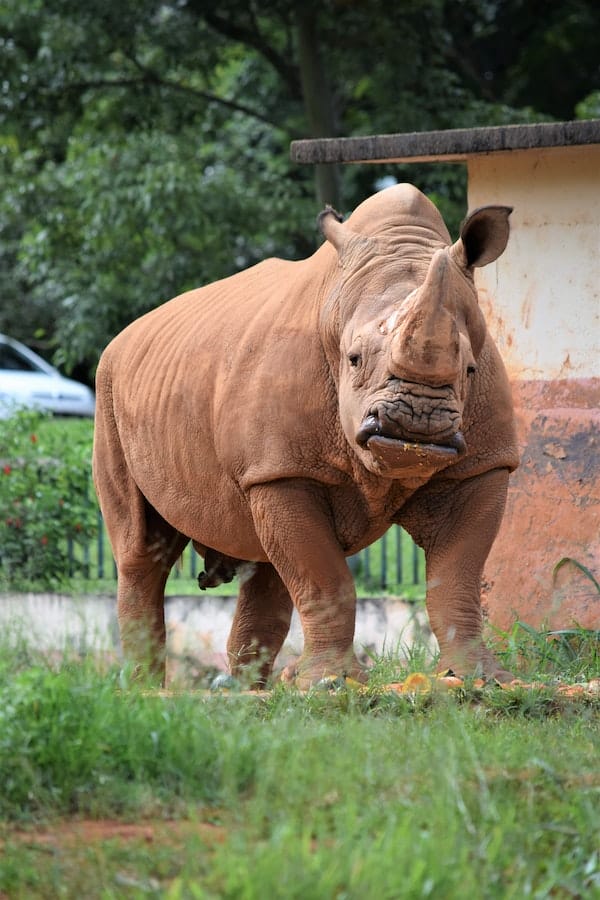
Rhinos are majestic and fascinating creatures that roamed the Earth long before humans.
They have a long history of co-existing with other animals, but unfortunately, their numbers have been drastically reduced due to poaching, habitat destruction, and other human activities.
Despite these challenges, there are still some incredible things to learn about rhinos.
Here are some interesting facts about these amazing animals.
Fact #1: Rhinos have very thick skin.
Rhinos’ skin is much thicker than other animals’ and can be up to 1.5 inches thick in some areas.
It helps protect them from the elements and potential predators, although their skin does not protect them from bullets and arrows fired by poachers.
In addition to being extremely tough, rhino skin has an oily coating that helps keep it hydrated and moist.
This natural defense gives rhinos the added protection they need against their harsh environment.
The thick skin also helps them regulate their body temperature, which is especially important in hot climates.
Fact #2: Rhinos can run up to 40 miles per hour.
Rhinos may not seem like the fastest animals, but they are surprisingly nimble and can reach high speeds.
They can run up to 40 miles per hour in short bursts, making them one of the speedier land mammals.
This fast movement helps them evade predators and quickly cover large distances for food or water.
Rhinos can also maintain their speed over long distances, making them one of the most efficient runners in the animal kingdom.
In addition to running, rhinos can swim quite efficiently, traversing various terrains easily.
Fact #3: Rhinos are herbivores.

Rhinos are strict herbivores, meaning they only consume plant-based foods.
They usually eat a variety of grasses and leaves, but they may also snack on fruits and berries when they can find them.
Rhinos have an incredibly strong sense of smell, which helps them locate their preferred food sources in the wild.
They have large stomachs that can hold a significant amount of food, allowing them to graze for several hours.
Rhinos prefer to browse and graze during the mornings and evenings when it is cooler outside, but they may also feed during the middle of the day to stay hydrated.
Fact #4: Rhinos are social animals.
Rhinos are naturally social creatures and often form large groups with other rhinos.
These herds can be comprised of a variety of different species, but the most common type is composed of white rhinos.
Female rhinos will typically stay with their herd for life, while males may move around more often.
These social animals will spend their time eating together, playing with each other, and even providing protection for one another in times of need.
Rhinos have also been observed to grieve when a herd member dies or is killed. This demonstrates their strong family-like bond and ability to feel emotions.
Fact #5: Rhinos have a long lifespan.
Rhinos can live up to 50 years in the wild and even longer in captivity. They reach sexual maturity around 4-7 years and breed for many years afterward.
A female rhino typically births one calf every 3-4 years, ensuring the species’ survival.
During this time, rhinos will have plenty of opportunities to explore and roam around for food and mates.
Rhinos are intelligent animals that can even learn certain behaviors from other herd members.
This long lifespan also allows them to pass on important knowledge about their habitat and the surrounding area to their offspring.
Fact #6: Rhinos are vulnerable to extinction.

Sadly, rhinos face an uncertain future due to poaching and habitat loss.
Only a few thousand are left in the wild, making them extremely vulnerable to extinction.
Poaching is one of the biggest threats they face, as their horns are highly sought after in some cultures and valuable on the black market.
Habitat loss is also a major issue, as humans have encroached on their natural habitats to make room for agriculture or development.
Conservation efforts are underway to help protect rhinos from these threats, but it remains an uphill battle for this iconic species.
- Related post: The Most Popular Rhino Names
- Related post: Best Names For Baby Rhinoceroses
Fact #7: Rhinos are important for the ecosystem.
Rhinos play a vital role in the health of their natural habitats and ecosystems, making them an integral part of our planet’s biodiversity.
As large animals, they help to keep grasses trimmed and provide nutrients through their droppings.
They also help disperse seeds from the plants they eat, helping maintain a healthy flora balance in their environment.
In addition, rhinos are apex predators, which helps control other species’ population levels.
This ensures that ecosystems remain stable and balanced, allowing various species to thrive.
Fact #8: Rhinos are symbols of strength.
Rhinos have long been viewed as powerful and strong animals, representing courage and perseverance in many cultures worldwide.
Their thick skin and large size make them formidable opponents, allowing them to protect themselves from predators and other threats.
Along with their strength, rhinos also have a gentle side and are known to form strong bonds with one another.
This combination of power and tenderness makes them perfect symbols of resilience and the ability to overcome adversity.
Fact #9: Rhinos have unique facial features.
Rhinos are easily recognizable due to their distinctively shaped faces.
Their nostrils are grouped together in the middle of their face, allowing them to take in more oxygen when running at high speeds.
They also have a prehensile upper lip, which helps them to grab food from the ground and carry it back to their mouths.
Rhinos’ eyes are relatively small compared to their face size, but they have excellent night vision due to their large pupils.
These unique facial features make rhinos easily distinguishable and help them stand out from other animals.
Fact #10: Rhinos have excellent senses.

Rhinos are equipped with incredibly sharp senses, allowing them to survive in the wild.
They have an acute sense of smell that helps them detect potential threats from far away.
They also have excellent hearing, which helps them avoid predators and stay aware of their surroundings.
In addition, rhinos have a strong sense of touch that assists in navigating through dense brush and finding food.
These combined senses make them exceptionally good at surviving in the wild and staying safe from harm.
Fact #11: Rhinos have multiple subspecies.
There are five different rhino species in the world, consisting of two African and three Asian species.
Each one has its unique characteristics and habitats, making them distinct from one another.
The African species include the white rhinoceros and the black rhinoceros, while the Asian species consist of the greater one-horned rhino, Javan rhino, and Sumatran rhino.
Each species is further divided into subspecies, allowing for even more diversity among these iconic animals.
Overall, rhinos are an incredibly important species that play a major role in their environments.
They are symbols of strength, have unique facial features and excellent senses, and come in multiple subspecies.
Unfortunately, poaching and habitat loss make it increasingly difficult for rhinos to survive in the wild, making it an uphill battle for this iconic species.


GIPHY App Key not set. Please check settings